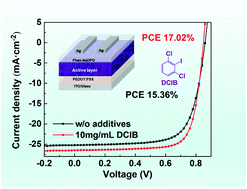A new simple volatile solid additive triggers morphological optimization and performance stabilization in polymer solar cells†
Abstract
To increase the power conversion efficiencies (PCEs) of organic solar cells (OSCs), the exploitation of excellent volatile solid additives is an important aspect for morphology optimization and performance stabilization. Here, we introduce a simple volatile solid additive 2,6-dichloroiodobenzene (DCIB) for OSCs, which carries one iodine (I) atom and two chlorine (Cl) atoms on the benzene ring. The additive promoted the formation of a continuous interpenetrating network and the orderly arrangement of molecules in the active layer by enhanced intermolecular interaction, which realized lower recombination and higher carrier lifetime in the optimized devices, ultimately obtaining higher mobilities and higher PCEs of 17.02% for PM6:Y6 OSCs. It is worth noting that the stability of the DCIB-treated devices is greatly improved, and the device efficiency remains at 95% of the initial efficiency after 25 days of storage in nitrogen atmosphere. This work provides a new volatile solid additive for the OSC system and its potential for future large-scale preparation.

- This article is part of the themed collection: Sustainable Energy & Fuels Recent HOT Articles


 Please wait while we load your content...
Please wait while we load your content...